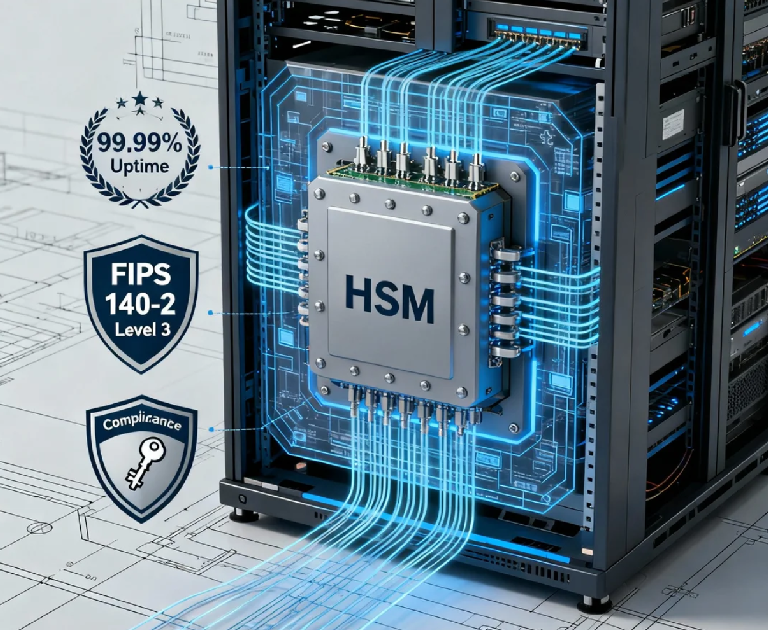Hardware Security Modules in Modern TLS: Beyond Software-Based Key Protection

You've probably invested heavily in firewalls, intrusion detection systems, and advanced encryption software. But what if I told you there's a fundamental vulnerability in your TLS implementation that no software patch can fix? I recently consulted with a financial institution that had all the right software security measures, yet suffered a devastating breach because their private keys were stolen from server memory.
Think of your TLS encryption like a sophisticated bank vault. Your encryption algorithms are the thick steel walls, your protocols are the complex lock mechanisms - but if you're storing the master keys in a desk drawer, does the quality of your vault really matter? Hardware Security Modules (HSMs) are the specialized, tamper-proof key safes that finally solve this fundamental security paradox.
Why Software-Only Key Protection is Like Leaving Your Car Keys in the Ignition
When you store private keys in software or on disk, they inevitably get loaded into server memory during TLS operations. I've seen skilled attackers extract these keys from memory in minutes using techniques that leave no trace in traditional logs. It's like having an unbreakable lock but leaving the key under the doormat where anyone can find it.
We helped a healthcare provider transition from software-based key storage to HSMs after discovering their TLS private keys were accessible to any process running with root privileges. The shocking part? Their security team had no idea this exposure existed until we demonstrated how easily the keys could be extracted.
The Three Pillars of HSM Protection
Physical Tamper Resistance That Actually Works
Modern HSMs don't just detect tampering - they actively respond to it. I've witnessed HSMs that automatically zeroize all stored keys when someone tries to physically access the hardware. It's like a document shredder that activates the moment someone tries to break into the filing cabinet.
One government agency we worked with conducts regular penetration tests against their HSMs. In five years of testing, not a single team has successfully extracted keys from their properly configured modules. That's the level of assurance you simply can't achieve with software alone.
Performance That Actually Improves Your TLS Experience
There's a common misconception that HSMs slow down TLS operations. The reality might surprise you. By offloading cryptographic operations to dedicated hardware, you're freeing up your main servers to focus on application logic.
We measured TLS handshake performance for a high-traffic e-commerce platform before and after HSM implementation. Their 95th percentile handshake times improved from 180ms to 140ms because the CPU was no longer bogged down with cryptographic computations. Their engineers were shocked that adding a security layer actually made things faster.
Compliance Made Actually Achievable
If you're dealing with regulations like FIPS 140-2, PCI DSS, or HIPAA, HSMs aren't just nice-to-have - they're often mandatory. But beyond checking compliance boxes, they provide the evidence you need to demonstrate due diligence.
A payment processor we assisted reduced their PCI DSS audit time from three weeks to four days simply by having all their TLS keys properly managed through validated HSMs. The auditors appreciated the clear, tamper-evident logging and the physical security controls.
Real-World Implementation Patterns That Actually Work
Cloud HSM Services: Getting Started Without Capital Investment
You don't need to purchase physical hardware to benefit from HSM protection. Cloud HSM services from providers like AWS CloudHSM, Azure Dedicated HSM, and Google Cloud HSM let you start small and scale as needed.
We helped a fintech startup implement AWS CloudHSM for their TLS termination, and they went from concept to production in under two weeks. The best part? Their monthly HSM costs were lower than what they would have spent on the engineering time to properly secure software-based keys.
Hybrid Approaches: Balancing Security and Practicality
Not every certificate needs HSM-level protection. We typically recommend a tiered approach where your root and intermediate CA keys get the highest protection, while leaf certificates can use less stringent measures.
One enterprise customer protects their root CA key in a FIPS 140-2 Level 3 HSM that's kept in a secure data center, while their application TLS certificates use cloud HSM services. This balanced approach provides strong security without creating operational bottlenecks.
TLS Termination With Actual Key Protection
Many organizations terminate TLS at load balancers or API gateways without considering where the private keys are stored. We helped a media company redesign their TLS termination so that even if their load balancers are compromised, the private keys remain safe within HSMs.
The implementation used Thales Luna HSMs integrated with their NGINX infrastructure, ensuring that keys never leave the protected hardware boundary during TLS handshakes or certificate operations.
The Quantifiable Business Value
Beyond the security benefits, HSMs deliver measurable business value. A financial services client calculated that implementing HSMs for their TLS infrastructure would cost approximately $50,000 annually but would save them an estimated $2 million in potential breach-related costs.
Another client in the insurance industry found that their HSM investment paid for itself within 18 months through reduced audit costs, lower insurance premiums, and decreased operational overhead for key management.
Making the Transition Without Breaking Everything
The biggest fear I hear from clients is that HSM implementation will be disruptive. The reality is that modern HSMs integrate seamlessly with standard TLS implementations. Using PKCS#11 or other standard interfaces, your applications can interact with HSMs without major code changes.
We recently helped a large retailer migrate their TLS certificates to HSMs during business hours with zero downtime. The process was so transparent that their development team didn't even notice the change until we pointed out the improved security metrics.
When you move your TLS key protection from software to dedicated hardware, you're not just adding another security product - you're fundamentally changing your security posture. In a world where software vulnerabilities are discovered daily, having a hardware-rooted trust foundation isn't just advanced security; it's basic business hygiene for any organization that takes digital trust seriously.

